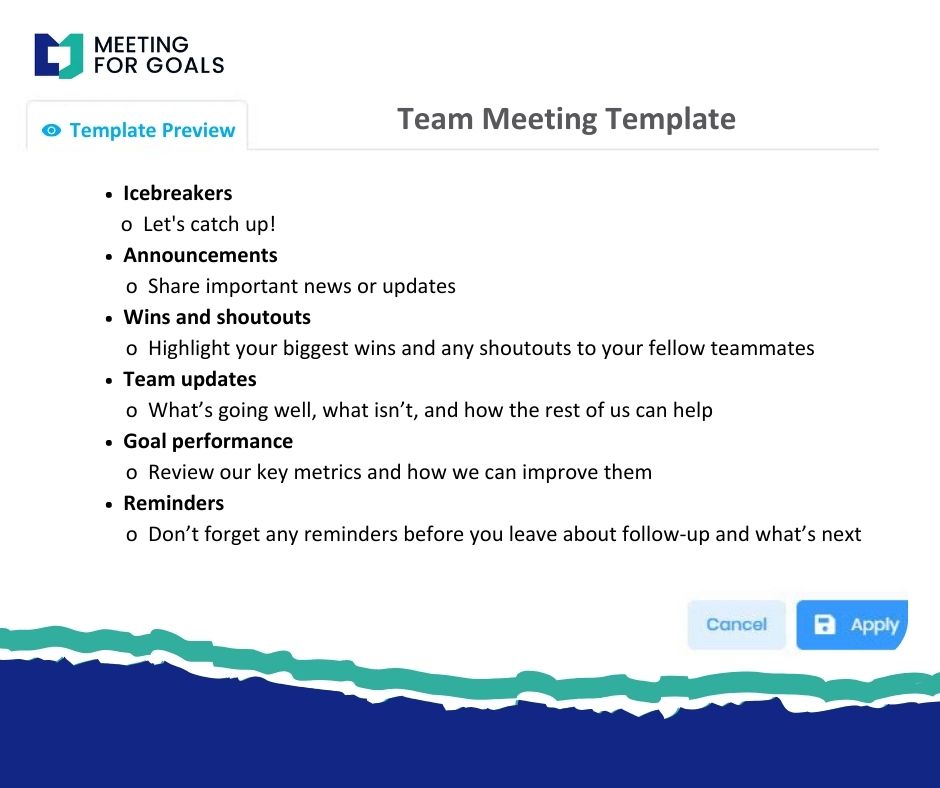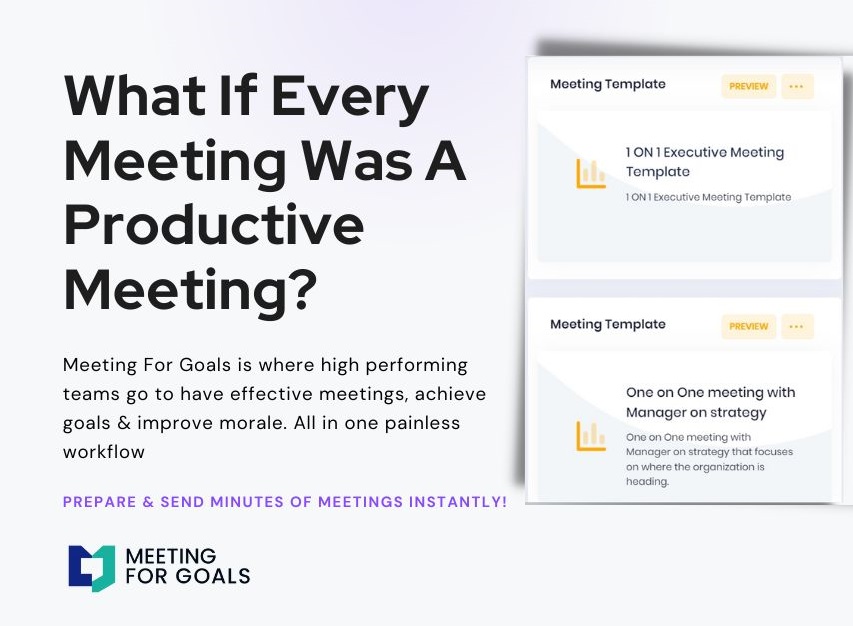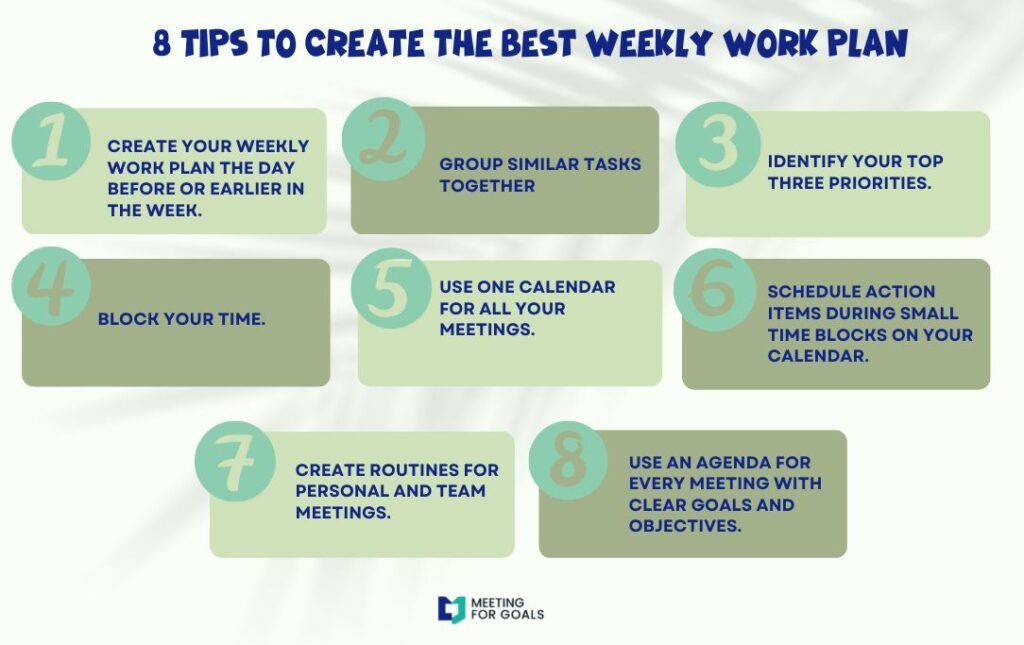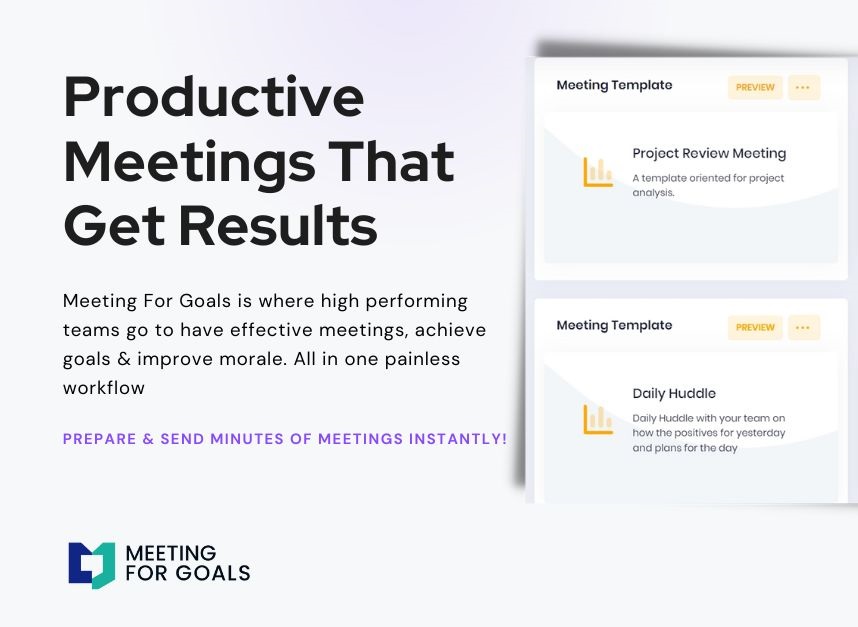Effective Skip Level Meeting Questions to Foster Team Connection and Productivity
Skip level meetings are one of the most underused yet powerful tools in a leader’s toolkit. Especially in growing companies with 40–70 employees, these meetings can help executives stay connected to their teams, gather unfiltered insights, and drive better alignment. When done right, skip level meetings can boost morale, uncover roadblocks, and help your organization move faster and smarter.
In this guide, we’ll walk you through how to make the most of skip level meetings using thoughtful preparation, strategic questions, and a clear follow-up process. Plus, we’ll show you how Meeting For Goals can help you streamline the entire experience so it’s easy to manage and delivers real results.
Ready to optimize your skip level meetings? Sign up for Meeting For Goals today and start building stronger team connections: https://app.meetingforgoals.com/TenantRegistration/Register
2 Minute Video
Watch a 2 minute demo of our meeting management software in action
What Are Skip Level Meetings?
Skip level meetings are conversations between employees and leaders who don’t directly report to each other—typically someone two or more levels apart in the org chart. For example, a VP might meet with a customer support rep, skipping over the direct manager.
The goal isn’t to micromanage or bypass the chain of command. Instead, it’s about creating an open line of communication that helps leaders stay connected to the front lines. These conversations uncover what’s working, what’s not, and how the team really feels.
In fast-growing companies, it’s easy for senior leadership to lose touch. Skip level meetings help bridge that gap.
Why They Matter:
- They build trust and transparency.
- They uncover issues early—before they become major problems.
- They align teams with company goals.
- They give employees a voice, which boosts engagement.
Want to make skip level meetings easier to run and more impactful? Check out our free meeting templates to get started: https://meetingforgoals.com/meeting_templates
Adding an Agenda
How to add an agenda instantly on Meeting For Goals
Why Skip Level Meetings Are a Game-Changer
A. They Improve Communication Across the Org
In many companies, communication flows top-down. Leaders give direction, and employees execute. But what about bottom-up feedback?
Skip level meetings give employees a rare chance to speak directly with leadership. This breaks down silos and creates a two-way street for communication.
When employees feel heard, they’re more likely to contribute ideas, raise concerns early, and stay engaged. And when leaders listen, they get a clearer picture of what’s happening on the ground.
According to a study by Gallup, employees who feel their opinions count are 4.6 times more likely to feel empowered to do their best work. That’s the power of listening.
B. They Help You Understand Team Morale
It’s hard to fix what you can’t see. Skip level meetings give leaders a window into how teams are really feeling.
- Are employees motivated?
- Frustrated?
- Burned out?
By asking the right questions, you can uncover the emotional pulse of your team. This helps you identify trends—like low morale in one department or confusion about a recent change—and take action before it impacts performance.
C. They Align Daily Work with Big-Picture Goals
Every employee wants to know their work matters. Skip level meetings are a chance to make that connection clear.
When leaders explain how a team’s work ties into company goals, it boosts motivation and focus. It also helps surface disconnects—like when employees don’t understand the “why” behind a project or feel they lack the tools to succeed.
This alignment drives better performance and helps everyone row in the same direction.
How to Prepare for a Great Skip Level Meeting
Like any good meeting, skip level conversations need preparation. Without it, they can feel awkward or superficial. Here’s how to set yourself—and your team—up for success.
A. Set a Clear Purpose
Before the meeting, decide what you want to learn. Are you checking in on morale? Gathering feedback on a recent project? Exploring team challenges?
Having a clear goal helps you ask better questions and stay focused.
B. Choose a Diverse Group
Don’t just meet with your top performers. To get a full picture, include team members from different roles, departments, and experience levels.
This diversity gives you richer insights and helps you avoid blind spots.
C. Communicate the Intent
Let employees know the purpose of the meeting in advance. Make it clear that it’s informal, not an evaluation. You’re there to listen, learn, and support.
This helps ease nerves and encourages open conversation.
D. Use a Simple Agenda
Structure helps keep the conversation on track, especially if you’re meeting with someone for the first time. Here’s a simple format:
- Welcome and purpose
- Team dynamics and morale
- Challenges and opportunities
- Alignment with company goals
- Open floor for ideas or concerns
- Wrap-up and next steps
Keep it conversational, not rigid. The best insights often come from unexpected places.
Want to save time preparing? Download our free skip level meeting agenda templates here: https://meetingforgoals.com/meeting_templates
The Best Questions to Ask in Skip Level Meetings
The questions you ask can make or break the meeting. You want to spark honest conversation, not just get “fine” as an answer.
Here are some powerful questions to consider—broken down by goal.
A. To Promote Open Communication
- “What’s one thing that’s going really well for you right now?”
- “What’s the biggest challenge you’re facing in your role?”
- “Is there anything you wish leadership understood better?”
- “What’s something that would make your day-to-day work easier?”
These questions show you’re genuinely interested in their experience—and open to hearing the truth.
B. To Gauge Morale and Engagement
- “What motivates you to do your best work?”
- “Do you feel recognized for your contributions?”
- “How supported do you feel by your manager and team?”
- “What would make your work experience more fulfilling?”
These help you understand how employees feel—and what they need to stay engaged.
C. To Check Alignment with Company Goals
- “Do you feel clear on the company’s top priorities?”
- “How does your work contribute to our mission?”
- “Are there any blockers keeping your team from hitting goals?”
- “What tools or support would help you be more effective?”
These questions highlight whether teams are aligned—or need more clarity or resources.
D. To Encourage Innovation and Feedback
- “If you could change one thing about how we work, what would it be?”
- “What’s an idea you’ve had recently that you haven’t shared yet?”
- “Are there any processes you think we could improve?”
These spark creativity and show employees their input is valued.
Want even more question ideas? Harvard Business Review has an excellent guide on how to ask better questions in leadership conversations: https://hbr.org/2018/05/the-surprising-power-of-questions
What to Do After the Meeting
The meeting itself is just the beginning. What you do afterward determines whether it creates real impact.
A. Capture and Organize Insights
Take notes during or right after the meeting. Group feedback into themes—like morale, communication, or alignment.
Use a tool like Meeting For Goals to tag insights, assign follow-ups, and track progress over time. This turns raw feedback into actionable steps.
B. Close the Loop
Don’t let feedback disappear into a black hole. Share non-confidential insights with relevant managers or teams, and take visible action where possible.
For example, if several employees mention unclear priorities, consider sending a company-wide update to clarify goals.
When employees see their feedback making a difference, they’re more likely to speak up again in the future.
C. Make It a Habit
Skip level meetings shouldn’t be a one-time thing. Schedule them quarterly or biannually, depending on your team size.
Use Meeting For Goals to create a recurring workflow that keeps meetings on track and aligned with your business goals.
You’ll build a culture of continuous feedback—and avoid surprises down the road.
D. Encourage Ongoing Feedback
In between skip level meetings, create other ways for employees to share input. Try anonymous surveys, suggestion boxes, or regular town halls.
Psychological safety—where people feel safe to speak up—is one of the top predictors of high-performing teams. Google’s Project Aristotle found that teams with high psychological safety consistently outperformed others: https://rework.withgoogle.com/print/guides/5721312655835136/
Conclusion: Make Skip Level Meetings Work for You
Skip level meetings are more than just a nice-to-have. They’re a strategic tool for building trust, boosting morale, and aligning your team with what matters most.
When you prepare thoughtfully, ask the right questions, and follow through on what you hear, you create a culture where people feel heard—and where performance thrives.
Want help making skip level meetings easier and more impactful?
👉 Try Meeting For Goals—our meeting management software designed for high-performing teams. With built-in workflows for skip level meetings, goal alignment, and accountability, we help you save time, improve morale, and make every meeting count.
Visit https://meetingforgoals.com to learn more and start transforming your team’s meeting culture today.
And if you’re ready to get started right now, sign up here: https://app.meetingforgoals.com/TenantRegistration/Register
Don’t forget to explore our free library of meeting templates to save time and run more effective meetings: https://meetingforgoals.com/meeting_templates
Your team’s success starts with better conversations. Let’s make every meeting count.




